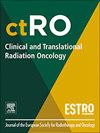Relating proton LETd to biological response of parotid and submandibular glands using PSMA-PET in clinical patients
IF 2.7
3区 医学
Q3 ONCOLOGY
引用次数: 0
Abstract
Background and purpose
A recent study investigated the use of PSMA-PET in monitoring loss of secretory cells in salivary glands of head and neck cancer (HNC) patients. Previously, a dose–effect relation has been formulated to the PSMA-PET uptake in salivary glands. The aim of this study was to derive a proton RBE model from the PSMA-PET uptake in salivary glands after proton therapy of HNC patients.
Materials and methods
Six patients treated with proton therapy were included. These patients received a PET-CT scan using 68Ga (N = 1) or 18F (N = 5) PSMA before treatment (baseline) and one month after the last fraction (follow-up). Physical dose (D), D·LETd and the follow-up PSMA-PET scan were deformed to the baseline PET-CT using deformable image registration. Parotid and submandibular gland delineations were adjusted to include voxels which had an uptake of ≥ 5 g/ml in the baseline PSMA-PET scan.
Results
The average RBE-LET slope was 0.075 [0.009; 0.125] (keV/μm)-1 (mean [95 %CI]) for parotid and submandibular glands combined. When analyzing parotid or submandibular glands separately the RBE-LET curve slope varies with two and five patients showing a positive RBE-LET slope when only analyzing parotid or submandibular glands respectively.
Conclusion
Our study did not find clear evidence of an increased RBE in parotid and submandibular glands with increasing LETd. On average an LETd effect was observed, however our sample size was too small to clearly define an RBE-LET relation. A larger cohort scanned at later time intervals could shed more light on this issue.
质子LETd与临床患者腮腺和颌下腺生物反应的PSMA-PET关系
背景与目的最近的一项研究探讨了PSMA-PET在监测头颈癌(HNC)患者唾液腺分泌细胞损失中的应用。以前,一种剂量效应关系已经制定了PSMA-PET在唾液腺摄取。本研究的目的是通过HNC患者质子治疗后唾液腺的PSMA-PET摄取来建立质子RBE模型。材料与方法对6例经质子治疗的患者进行分析。这些患者在治疗前(基线)和最后一个分数后一个月(随访)使用68Ga (N = 1)或18F (N = 5) PSMA进行PET-CT扫描。物理剂量(D)、D·LETd和随访的PSMA-PET扫描通过可变形图像配准变形为基线PET-CT。调整腮腺和下颌骨腺的描绘,包括基线PSMA-PET扫描中摄取≥5 g/ml的体素。结果RBE-LET平均斜率为0.075 [0.009;0.125] (keV/μm)-1(平均值[95% CI])。单独分析腮腺或颌下腺时,RBE-LET曲线斜率不同,分别有2例和5例患者分别分析腮腺或颌下腺时RBE-LET斜率为正。结论我们的研究没有发现明确的证据表明腮腺和下颌骨腺的RBE随着LETd的增加而增加。平均而言,观察到LETd效应,但是我们的样本量太小,无法清楚地定义RBE-LET关系。在以后的时间间隔内对更大的队列进行扫描可能会对这个问题有更多的了解。
本文章由计算机程序翻译,如有差异,请以英文原文为准。
求助全文
约1分钟内获得全文
求助全文
来源期刊

Clinical and Translational Radiation Oncology
Medicine-Radiology, Nuclear Medicine and Imaging
CiteScore
5.30
自引率
3.20%
发文量
114
审稿时长
40 days
 求助内容:
求助内容: 应助结果提醒方式:
应助结果提醒方式:


